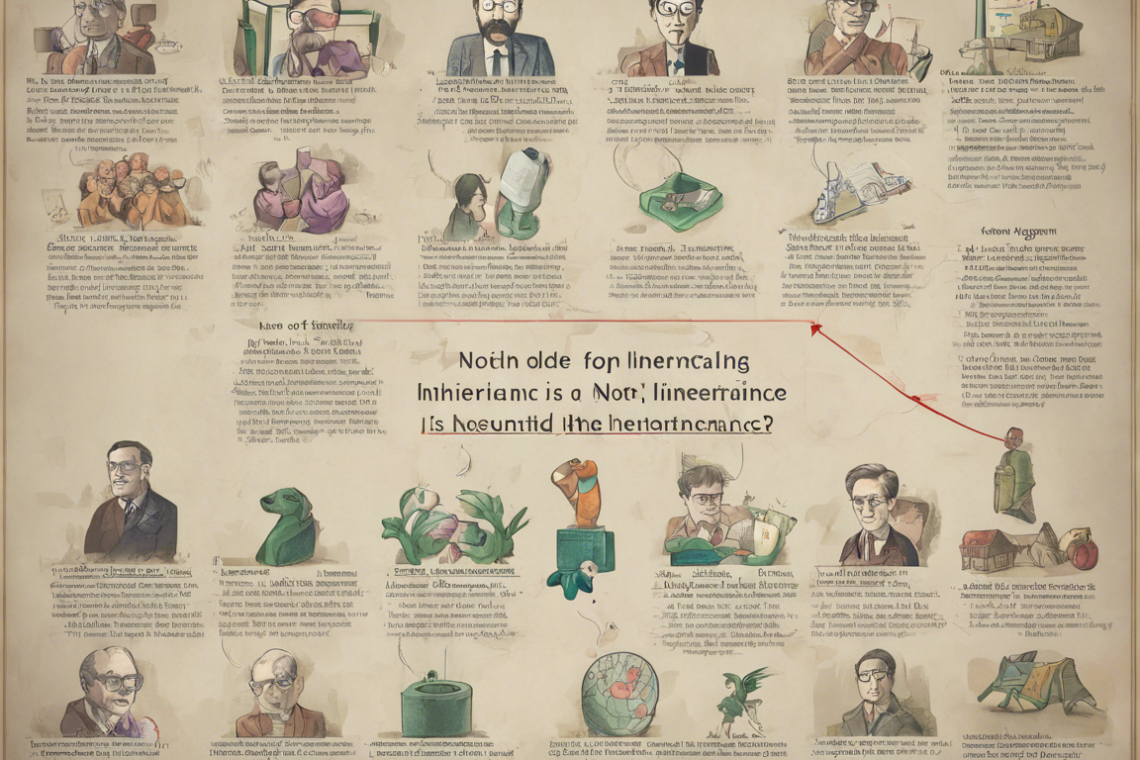Types of Inheritance in Object-Oriented Programming: A Comprehensive Guide
Inheritance in object-oriented programming (OOP) is a fundamental concept that allows for the creation of new classes based on existing classes. It promotes code reusability, flexibility, and maintainability by enabling derived classes to inherit attributes and methods from base classes. Inheritance establishes an “is-a” relationship between classes, where a derived class is a specialized version of a base class. This comprehensive guide explores the various types of inheritance and their implementations in OOP.
1. Single Inheritance:
In single inheritance, a derived class inherits attributes and methods from a single base class. This is the simplest form of inheritance where one class serves as the superclass, and another class extends it. For example, consider a base class “Animal” with attributes and methods common to all animals. A derived class “Dog” can inherit from the “Animal” class to specialize in specific dog-related attributes and methods.
2. Multiple Inheritance:
Multiple inheritance allows a derived class to inherit attributes and methods from more than one base class. This form of inheritance enables a class to combine features from multiple classes. While powerful, multiple inheritance can lead to complexities, such as the “diamond problem,” where ambiguity arises due to overlapping methods from different base classes. Some programming languages like Java do not support multiple inheritance to avoid such issues.
3. Multilevel Inheritance:
In multilevel inheritance, a class derives from another derived class, creating a hierarchy of classes. This type of inheritance forms a parent-child relationship across multiple levels. For instance, consider a base class “Vehicle,” a derived class “Car” inheriting from “Vehicle,” and another class “Sedan” inheriting from “Car.” Each subsequent class inherits properties from its immediate parent class, forming a chain of inheritance.
4. Hierarchical Inheritance:
Hierarchical inheritance involves multiple derived classes inheriting from a single base class. This type of inheritance allows for specialization in different directions while sharing common attributes and methods from the base class. For example, a base class “Shape” can have derived classes like “Circle,” “Square,” and “Triangle,” each incorporating specific properties of their respective shapes while inheriting common features from “Shape.”
5. Hybrid (Virtual) Inheritance:
Hybrid inheritance, also known as virtual inheritance, combines multiple inheritance with other forms of inheritance to create complex inheritance structures. This technique addresses issues like the “diamond problem” by using virtual base classes to ensure that only one instance of a shared base class exists in the derived class hierarchy. Virtual inheritance is often used in languages like C++ to manage intricate class relationships efficiently.
6. Simulated Inheritance:
Simulated inheritance mimics inheritance in languages that do not support traditional inheritance, like JavaScript. This approach involves creating objects that act as instances of classes and implementing prototype-based inheritance. By linking objects to serve as prototypes for other objects, simulated inheritance allows for code reuse and hierarchy establishment in languages with prototype-based OOP models.
Implementing Inheritance in OOP:
To implement inheritance in OOP languages like Java, C++, or Python, classes are defined using keywords like “extends” (Java), “class: public” (C++), or “class ClassName(BaseClassName)” (Python). Inheritance relationships are established by specifying a base class from which a derived class inherits. Methods and attributes from the base class can be accessed and overridden in the derived class to customize functionality while maintaining code reusability.
Advantages of Inheritance:
- Code Reusability: Inheritance promotes reusing existing code, reducing redundancy, and enhancing productivity.
- Flexibility: Derived classes can extend or modify the behavior of base classes, providing flexibility in OOP design.
- Maintainability: Changes made to a base class automatically reflect in derived classes, simplifying maintenance tasks.
- Modularity: Inheritance allows for creating modular and organized class hierarchies, improving code structure.
Challenges of Inheritance:
- Complexity: Multiple levels of inheritance can lead to complex class hierarchies that are challenging to understand and maintain.
- Tight Coupling: Excessive interdependence between base and derived classes can result in tight coupling, making it difficult to modify classes independently.
- Inheritance Abuse: Overusing inheritance can lead to bloated class hierarchies and hinder code readability and extensibility.
- Diamond Problem: In multiple inheritance scenarios, conflicts may arise when two base classes share a common ancestor, leading to ambiguity in method resolution.
Best Practices for Using Inheritance:
- Favor Composition over Inheritance: When possible, prefer composition to inheritance to achieve code reuse while avoiding the complexities associated with deep class hierarchies.
- Keep Hierarchies Shallow: Limit the depth of class hierarchies to maintain simplicity and avoid excessive dependencies between classes.
- Use Interfaces or Abstract Classes: Define interfaces or abstract classes to provide a blueprint for derived classes without enforcing a specific implementation.
- Avoid Multiple Inheritance: If possible, avoid multiple inheritance to prevent the complications arising from the diamond problem and overlapping method resolutions.
- Follow the Liskov Substitution Principle: Ensure that derived classes can substitute their base classes without affecting the program’s functionality, maintaining the principle of polymorphism in OOP.
Frequently Asked Questions (FAQs) About Inheritance in OOP:
Q1. What is the difference between inheritance and polymorphism in OOP?
A: Inheritance focuses on creating a hierarchy of classes where derived classes inherit attributes and methods from base classes, promoting code reuse. Polymorphism, on the other hand, allows objects of different classes to be treated as objects of a common superclass, enabling flexibility in method implementation.
Q2. How does inheritance contribute to code reusability in OOP?
A: By inheriting attributes and methods from base classes, derived classes can reuse existing code without the need for redundant implementations. This promotes a more efficient and organized codebase.
Q3. What is the significance of the “super” keyword in Java inheritance?
A: In Java, the “super” keyword is used to refer to the superclass of a derived class. It can be used to invoke superclass constructors, methods, and properties, allowing derived classes to access and extend the behavior of their parent classes.
Q4. Can inheritance lead to tight coupling between classes in OOP?
A: Yes, excessive use of inheritance can result in tight coupling between base and derived classes, making it challenging to modify or extend classes independently. This can hinder code maintainability and flexibility.
Q5. How does the diamond problem occur in multiple inheritance?
A: The diamond problem arises in multiple inheritance when a derived class inherits from two classes that have a common ancestor. This leads to ambiguity in method resolution, as the derived class may have access to duplicate copies of methods from the shared base class.
Q6. Is multiple inheritance supported in all programming languages?
A: No, not all programming languages support multiple inheritance due to its complexities and potential issues like the diamond problem. Languages like Java prefer single inheritance and offer interfaces as an alternative mechanism for achieving multiple inheritance-like behavior.
Q7. How can inheritance improve the modularity of code in OOP?
A: Inheritance allows for organizing classes into hierarchies based on their relationships, promoting modularity and encapsulation. By inheriting attributes and methods from base classes, derived classes can specialize in specific functionalities while maintaining a structured codebase.
Q8. What are the different types of inheritance relationships in OOP?
A: Inheritance relationships in OOP include single inheritance (one derived class inherits from one base class), multiple inheritance (one derived class inherits from multiple base classes), multilevel inheritance (a class inherits from a derived class), hierarchical inheritance (multiple classes inherit from a single base class), and hybrid (virtual) inheritance (combining multiple inheritance with other forms of inheritance).
Q9. How does simulated inheritance work in languages like JavaScript?
A: Simulated inheritance in languages like JavaScript involves creating objects that serve as prototypes for other objects, mimicking inheritance through a prototype chain. By linking objects as prototypes, simulated inheritance enables code reuse and hierarchy establishment in prototype-based OOP models.
Q10. What are the common advantages and challenges of using inheritance in OOP?
A: The advantages of using inheritance in OOP include code reusability, flexibility, maintainability, and modularity. However, challenges such as complexity, tight coupling, inheritance abuse, and the diamond problem may arise when implementing inheritance in complex class hierarchies.








